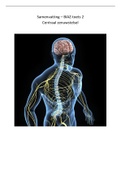Summary
BIAZ/BAZ samenvatting Centraal zenuwstelsel
Deze samenvatting is gemaakt ter voorbereiding voor de BIAZ/BAZ (Basis Inleiding Acute Zorg). De samenvatting is gebaseerd op het thema Circulatie één van de drie onderdelen van de BIAZ/BAZ. De samenvatting is gemaakt aan de hand van theorie uit de boeken Anatomie en fysiologie een inleiding en P...
[Show more]
Preview 4 out of 91 pages
Uploaded on
November 10, 2021
Number of pages
91
Written in
2021/2022
Type
Summary
Institution
Erasmus Universiteit Rotterdam (EUR)
Education
Intensive Care Verpleegkundige
Course
BAZ Centraal zenuwstelsel
All documents for this subject (1)
By: jaimysleeuwenhoek • 1 year ago
By: marlisesmits1998 • 1 year ago
By: manoukbraamskamp • 1 year ago
By: info2317 • 2 year ago
$9.65
Also available in package deal from $16.63
100% satisfaction guarantee
Immediately available after payment
Both online and in PDF
No strings attached
Also available in package deal (1)
Samenvattingen BIAZ/BAZ van Erasmus MC
1. Summary - Baz/biaz samenvatting respiratie
2. Summary - Baz/biaz samenvatting circulatie
3. Summary - Biaz/baz samenvatting centraal zenuwstelsel
Show more
Samenvatting – BIAZ-toets 2




